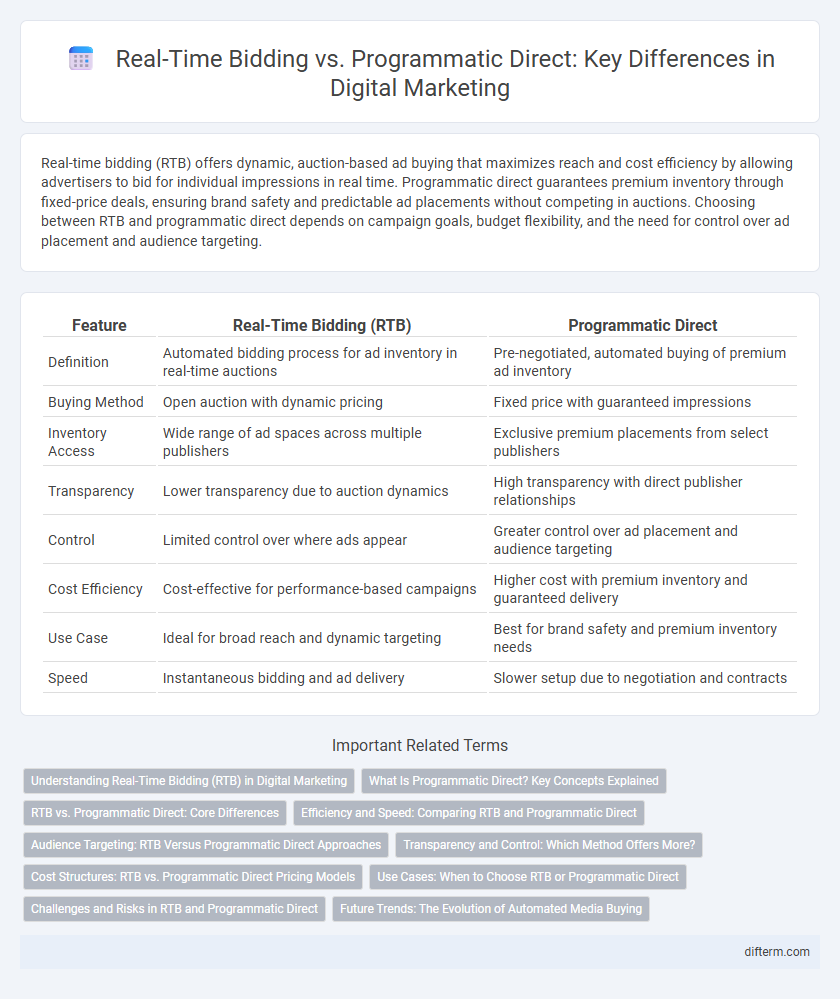Real-time bidding (RTB) offers dynamic, auction-based ad buying that maximizes reach and cost efficiency by allowing advertisers to bid for individual impressions in real time. Programmatic direct guarantees premium inventory through fixed-price deals, ensuring brand safety and predictable ad placements without competing in auctions. Choosing between RTB and programmatic direct depends on campaign goals, budget flexibility, and the need for control over ad placement and audience targeting.
Table of Comparison
| Feature | Real-Time Bidding (RTB) | Programmatic Direct |
|---|---|---|
| Definition | Automated bidding process for ad inventory in real-time auctions | Pre-negotiated, automated buying of premium ad inventory |
| Buying Method | Open auction with dynamic pricing | Fixed price with guaranteed impressions |
| Inventory Access | Wide range of ad spaces across multiple publishers | Exclusive premium placements from select publishers |
| Transparency | Lower transparency due to auction dynamics | High transparency with direct publisher relationships |
| Control | Limited control over where ads appear | Greater control over ad placement and audience targeting |
| Cost Efficiency | Cost-effective for performance-based campaigns | Higher cost with premium inventory and guaranteed delivery |
| Use Case | Ideal for broad reach and dynamic targeting | Best for brand safety and premium inventory needs |
| Speed | Instantaneous bidding and ad delivery | Slower setup due to negotiation and contracts |
Understanding Real-Time Bidding (RTB) in Digital Marketing
Real-time bidding (RTB) in digital marketing is an automated process where ad impressions are bought and sold instantly through an auction, allowing advertisers to target specific audiences with precision and efficiency. RTB optimizes ad spend by enabling advertisers to bid for impressions in milliseconds based on user data and campaign goals, enhancing real-time audience engagement. Unlike programmatic direct, RTB offers a more dynamic and flexible purchasing environment, maximizing reach and cost-effectiveness across multiple digital channels.
What Is Programmatic Direct? Key Concepts Explained
Programmatic Direct is a digital advertising method where buyers and sellers negotiate fixed-price deals for premium inventory, ensuring guaranteed ad placements without auction bidding. This approach streamlines transactions with automated workflows while maintaining transparency and control over targeting and campaign parameters. Unlike real-time bidding (RTB), Programmatic Direct offers predictability in media buying by eliminating competition through direct agreements between advertisers and publishers.
RTB vs. Programmatic Direct: Core Differences
Real-time bidding (RTB) operates through an open auction model where advertisers bid for individual ad impressions in milliseconds, maximizing reach and cost efficiency. Programmatic direct involves pre-negotiated deals between advertisers and publishers, offering guaranteed inventory and premium placements without the variability of auctions. RTB excels in dynamic targeting and scale, while programmatic direct provides brand safety and predictable campaign outcomes.
Efficiency and Speed: Comparing RTB and Programmatic Direct
Real-time bidding (RTB) enables advertisers to compete for ad impressions instantly through automated auctions, maximizing efficiency by targeting specific audiences at scale with minimal manual intervention. Programmatic direct streamlines the buying process by securing premium inventory in advance, offering predictable ad placements and reducing the latency often associated with RTB auctions. While RTB excels in speed and flexibility for dynamic campaigns, programmatic direct enhances operational efficiency through guaranteed inventory and simplified negotiation workflows.
Audience Targeting: RTB Versus Programmatic Direct Approaches
Real-time bidding (RTB) leverages dynamic auctions to enable granular audience targeting based on real-time data signals, maximizing reach and cost-efficiency across diverse inventory. Programmatic direct offers predefined audience segments with guaranteed impressions, ensuring premium ad placements and consistent brand safety. Both methods utilize data-driven insights but differ in targeting precision and delivery control, catering to varying campaign objectives.
Transparency and Control: Which Method Offers More?
Real-time bidding (RTB) offers advertisers dynamic transparency through real-time data access, enabling precise control over bid adjustments and audience targeting. Programmatic direct provides enhanced control over placements and pricing with guaranteed inventory, but transparency can be limited due to less frequent data feedback loops. Advertisers seeking granular visibility and instant decision-making benefit more from RTB, while those prioritizing fixed deals and predictable outcomes may prefer programmatic direct.
Cost Structures: RTB vs. Programmatic Direct Pricing Models
Real-time bidding (RTB) operates on a dynamic auction-based pricing model where advertisers bid for individual impressions in real time, often resulting in lower costs due to market competition and variable demand. Programmatic Direct utilizes fixed or negotiated pricing with guaranteed ad placements, providing predictability but typically higher expenses reflecting premium inventory and assured campaign delivery. Understanding these distinct cost structures enables marketers to balance budget efficiency with campaign control and reach.
Use Cases: When to Choose RTB or Programmatic Direct
Real-time bidding (RTB) is ideal for advertisers seeking flexible, auction-based access to diverse audience segments and dynamic budget allocation in performance-driven campaigns. Programmatic direct suits premium brand campaigns requiring guaranteed ad placements, fixed pricing, and access to high-quality inventory with predictable reach. Choosing RTB supports rapid optimization and granular targeting, while programmatic direct ensures brand safety and consistent exposure in controlled environments.
Challenges and Risks in RTB and Programmatic Direct
Real-time bidding (RTB) faces challenges such as ad fraud, lack of transparency, and price volatility due to its open auction environment, increasing the risk of wasted ad spend and reduced ROI. Programmatic direct offers more predictable inventory and guaranteed ad placements but carries risks related to less flexibility and potentially higher costs, limiting quick adjustments based on campaign performance. Both methods require robust data security measures and rigorous partner vetting to mitigate fraud and ensure brand safety.
Future Trends: The Evolution of Automated Media Buying
Real-time bidding (RTB) and programmatic direct are shaping the future of automated media buying by integrating advanced AI algorithms and machine learning to optimize ad placements and targeting in milliseconds. Emerging trends highlight a shift towards hybrid models combining RTB's auction-based flexibility with programmatic direct's guaranteed inventory, enhancing efficiency and transparency for advertisers. Continuous innovation in data analytics and privacy-compliant technologies is driving the evolution of programmatic advertising, ensuring more personalized and measurable campaign outcomes.
Real-time bidding vs programmatic direct Infographic

 difterm.com
difterm.com